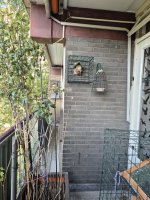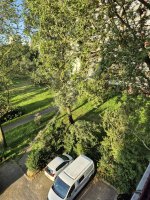I know they're many treads here about sparrowhawks visiting bird feeders. But in most cases this is in gardens, and in this case it is on a balcony on the fourth floor.
On this balcony I'll placed different bird feeders with protective cages around it.
I live in front of a small park with lots of bushes and trees. On my balcony I placed lots of native plants (I live in the Netherlands) and even a small pear tree. Plenty of cover for the birds you might say.
This time of year I feed the birds (almost only Blue and Great Tits) live mealworms. Also we placed a bird bath with protecting cage and even a small pond.
So you might imagine how busy it is on our balcony. Lots of juveniles and also adults that feeding there chicks with live mealworms.
But all that comotions had attracted the attention of a female sparrowhawk.
This not the first time tough, last year it was a male that payed visits on my balcony for weeks, almost on a daily basis. Never saw him successfully catch a bird though ,but I'm sure he has been successful sometimes.
But this female is pretty successful. Not that much on the balcony itself, but what's she does is suddenly make an appearance and scared the birds away from the balcony. Then she chased an individual into the trees. It's not that she's always successful, but she's a pretty good hunter and I witness some successful kills.
Of course she's a beautiful bird and she have to feed too.
But my main concern is that I make it to easy for her to catch her prey.
This is because although I tried to make it as safe as possible, the small birds still have to make a flight over open space to reach cover from the bushes and trees around the balcony.
What I already did is making an open space trough the fence of the balcony (if that make sense) to reach safety faster. Also they have of course the protection of the cages so that the Sparrowhawk can't catch them directly from the bird table itself. And then there are the plants on the balcony where they're take shelter.
There's nothing more I could do, I think.
My question to you is if I'll do good to keep continue feeding the birds.
Also I wish that I just can accept this part of nature, but I've so much difficulty to . It almost felt that it is my fault because I give the Sparrowhawk an easy meal. Although I admire the Sparrowhawk much and I know she has to feed herself. I just don't want to make it to easy for her.
I hope I can get some tips what I'll should do.
Thanks in advance
Bianca
On this balcony I'll placed different bird feeders with protective cages around it.
I live in front of a small park with lots of bushes and trees. On my balcony I placed lots of native plants (I live in the Netherlands) and even a small pear tree. Plenty of cover for the birds you might say.
This time of year I feed the birds (almost only Blue and Great Tits) live mealworms. Also we placed a bird bath with protecting cage and even a small pond.
So you might imagine how busy it is on our balcony. Lots of juveniles and also adults that feeding there chicks with live mealworms.
But all that comotions had attracted the attention of a female sparrowhawk.
This not the first time tough, last year it was a male that payed visits on my balcony for weeks, almost on a daily basis. Never saw him successfully catch a bird though ,but I'm sure he has been successful sometimes.
But this female is pretty successful. Not that much on the balcony itself, but what's she does is suddenly make an appearance and scared the birds away from the balcony. Then she chased an individual into the trees. It's not that she's always successful, but she's a pretty good hunter and I witness some successful kills.
Of course she's a beautiful bird and she have to feed too.
But my main concern is that I make it to easy for her to catch her prey.
This is because although I tried to make it as safe as possible, the small birds still have to make a flight over open space to reach cover from the bushes and trees around the balcony.
What I already did is making an open space trough the fence of the balcony (if that make sense) to reach safety faster. Also they have of course the protection of the cages so that the Sparrowhawk can't catch them directly from the bird table itself. And then there are the plants on the balcony where they're take shelter.
There's nothing more I could do, I think.
My question to you is if I'll do good to keep continue feeding the birds.
Also I wish that I just can accept this part of nature, but I've so much difficulty to . It almost felt that it is my fault because I give the Sparrowhawk an easy meal. Although I admire the Sparrowhawk much and I know she has to feed herself. I just don't want to make it to easy for her.
I hope I can get some tips what I'll should do.
Thanks in advance
Bianca













